Pneumonia is one of the leading causes of death in Japan.
While many associate pneumonia with COVID-19, aspiration pneumonia has a different cause.
Aspiration pneumonia occurs when food, liquids, or saliva mistakenly enter the airway, causing inflammation.
According to data from Japan’s Ministry of Health, Labour and Welfare, more than 60,000 people died of aspiration pneumonia in 2022—surpassing the annual death toll from COVID-19.
With Japan’s aging population, this number is expected to rise further.
As a result, oral function and aspiration prevention have become essential concerns in elderly care and nursing.
In previous posts, I have introduced products aimed at reducing aspiration risk.
This time, I’d like to introduce “Isotonic Jelly”, a jelly drink we recently tried in our facility to support alternating swallowing.
I’ll share our practical experiences and discuss key characteristics of easy-to-swallow jellies based on relevant patent information.
[PR/Advertisement: This article includes a review of products provided as trial samples. Some links may be affiliate links.]
Understanding Swallowing and Aspiration
Swallowing is a coordinated process that occurs in three main phases:
- Oral phase – food or liquid is prepared and moved to the back of the mouth.
- Pharyngeal phase – it passes through the throat while the airway is briefly closed to prevent aspiration.
- Esophageal phase – it enters the esophagus and moves toward the stomach.
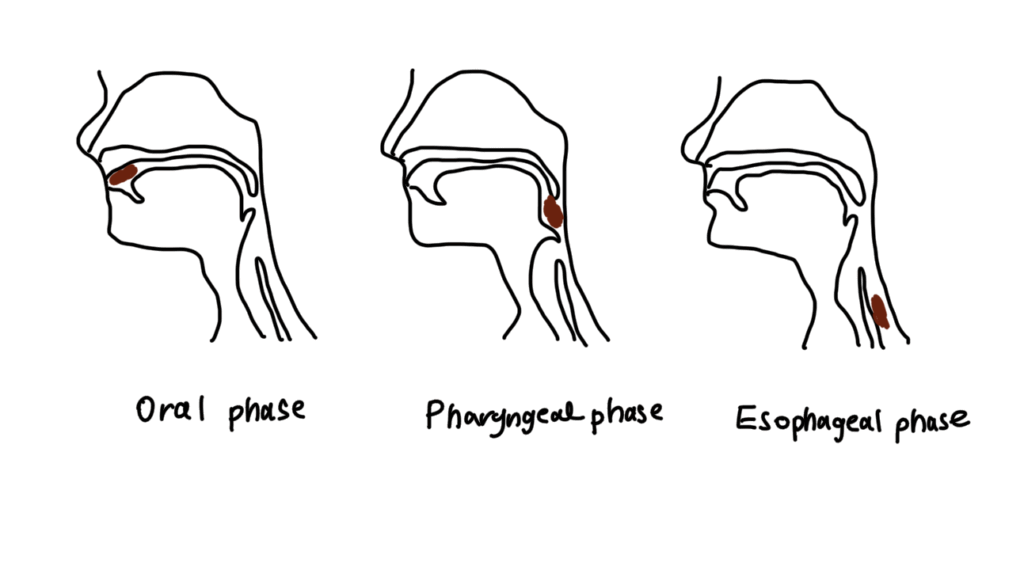
In individuals with dysphagia, this process may be impaired—particularly during the pharyngeal phase—leading to residue remaining in the throat or material mistakenly entering the airway, both of which increase the risk of aspiration.
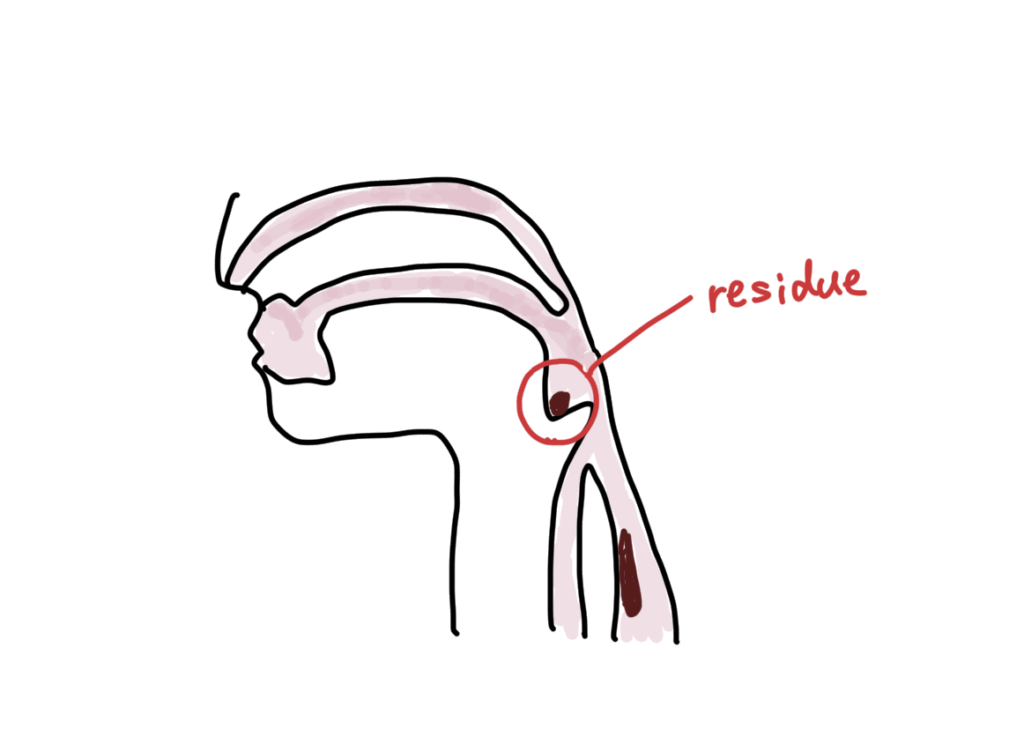
Healthy individuals can usually perform a second swallow to clear any leftover residue, but this reflex may be absent or weakened in those with impaired swallowing.
What is Alternating Swallowing?
Alternating swallowing involves switching between different textures—for example, swallowing food followed by a thickened liquid or jelly—to help wash down any residue in the mouth or throat.
Thickened tea or water is often used, but some individuals dislike the taste, especially when bitterness is intensified by thickeners.
Jellies tend to be generally well received, though sweetness or calorie content can be problematic depending on the person’s condition.
Introducing Isotonic Jelly
Developed by Nutri Co., Ltd., Isotonic Jelly is a ready-to-drink jelly formulated to support hydration and alternating swallowing in individuals with dysphagia.
(This link leads to a Japan-based affiliate website.)
We obtained trial samples and evaluated them based on our real-world experiences and the manufacturer’s product literature.
Key Features
- Ready-to-use and requires no thickening or cleanup.
- Formulated as a gel with low adhesiveness and high cohesiveness:
- Low adhesiveness: less likely to stick to the throat
- High cohesiveness: holds its shape in the mouth and is easy to control during swallowing
- Contains electrolytes and is virtually calorie-free, making it suitable for hydration
- Features a narrow spout that allows the jelly to be sipped directly from the container in small, controlled amounts
- Shelf-stable and maintains a consistent texture at room or chilled temperatures
- Available in colored versions to help visually confirm if any jelly remains in the mouth
(This link leads to a Japan-based affiliate website.)
Use Cases
Supporting Alternating Swallowing
We used Isotonic Jelly with a fully assisted patient who typically relies on thickened tea.
The jelly was swallowed smoothly in our case, and we did not notice any obvious signs of aspiration during use.
While the level of assistance remained similar, the product reduced the need for:
- Tilting cups at careful angles
- Managing fluids that don’t flow well
- Spoon-feeding
Personally, I find cup tilting during fluid assistance stressful, so this product significantly reduced that burden.
For Patients Who Prefer Sweets
One resident, who disliked water or tea but loved sweet foods, was previously encouraged to hydrate with the promise of ice cream afterward.
We offered chilled Isotonic Jelly, explaining, “You can drink it like a frozen jelly snack that you suck directly from the pouch.”
He said the flavor was mild but easier to take than tea.
The trial originated as a response to this patient’s low fluid intake—and based on their reaction, it was successful.
Tasting and Handling Notes
- The jelly is almost flavorless, with a subtle sweetness and citrusy note.
Those expecting a sports drink flavor may find it not as sweet or flavorful as expected.
For patients who prefer sweeter options or need extra nutrients, the IsoFO Jelly (with oligosaccharides and dietary fiber) may be more suitable.

(This link leads to a Japan-based affiliate website.)
- Be careful when opening.
If opened upright, the jelly may squirt out.
Even when opened downward, some spillage occurred, so a better design could be helpful. - The narrow spout releases a moderately crushed jelly that’s easy to consume.
When first sucked, a small amount of separated liquid may come out, but the texture remains cohesive and doesn’t become watery in the mouth. - The container has four small protrusions at the base, allowing it to stand upright—handy during feeding assistance.
Price and Product Variations
- Available in 100 ml and 150 ml sizes
- Retail price: approx. 100–125 yen per pouch
- Bulk purchases (30-pack) can reduce the price to under 100 yen per unit
Three product types are available:
- Standard
- Colored (to help confirm oral residue)
- IsoFO (containing oligosaccharides and dietary fiber, which may help supplement daily intake)
Patent Insight: What Makes a Jelly “Easy to Swallow”?
I reviewed the following patent to understand the technical innovations behind swallowable jelly drinks:
[JP6453547B2]
“Hydration jelly drink for people with difficulty in chewing and swallowing”
Applicant: Unitec Foods Co., Ltd.
Problems with Conventional Jellies
- Many rely on thickening polysaccharides, resulting in high adhesiveness and poor cohesion.
- Most contain separated liquid (syneresis), increasing the risk of aspiration.
- Crushed jellies often fragment and lack re-cohesiveness, posing a safety risk.
Solutions Proposed in the Patent
- Provides re-cohesiveness after breakdown
- Reduces adhesiveness to mucosal surfaces
- Maintains slipperiness and a smooth texture by retaining moisture within the gel, thereby improving ease of swallowing and helping reduce residue
The core of this innovation is the combination of low-methoxyl pectin (LM pectin) and calcium salts.
Pectin and the Degree of Esterification
Pectin is a natural polysaccharide found in fruit, commonly used as a gelling agent in food products.
Its behavior depends on its degree of esterification (DE)—the percentage of galacturonic acid residues that are methyl-esterified.
- When DE ≥ 50%, it’s called high-methoxyl pectin (HM pectin)
- When DE < 50%, it’s called low-methoxyl pectin (LM pectin)
What Is Esterification?
Esterification is a chemical reaction where a carboxylic acid (–COOH) reacts with an alcohol, forming an ester (–COO–) and water (H₂O).
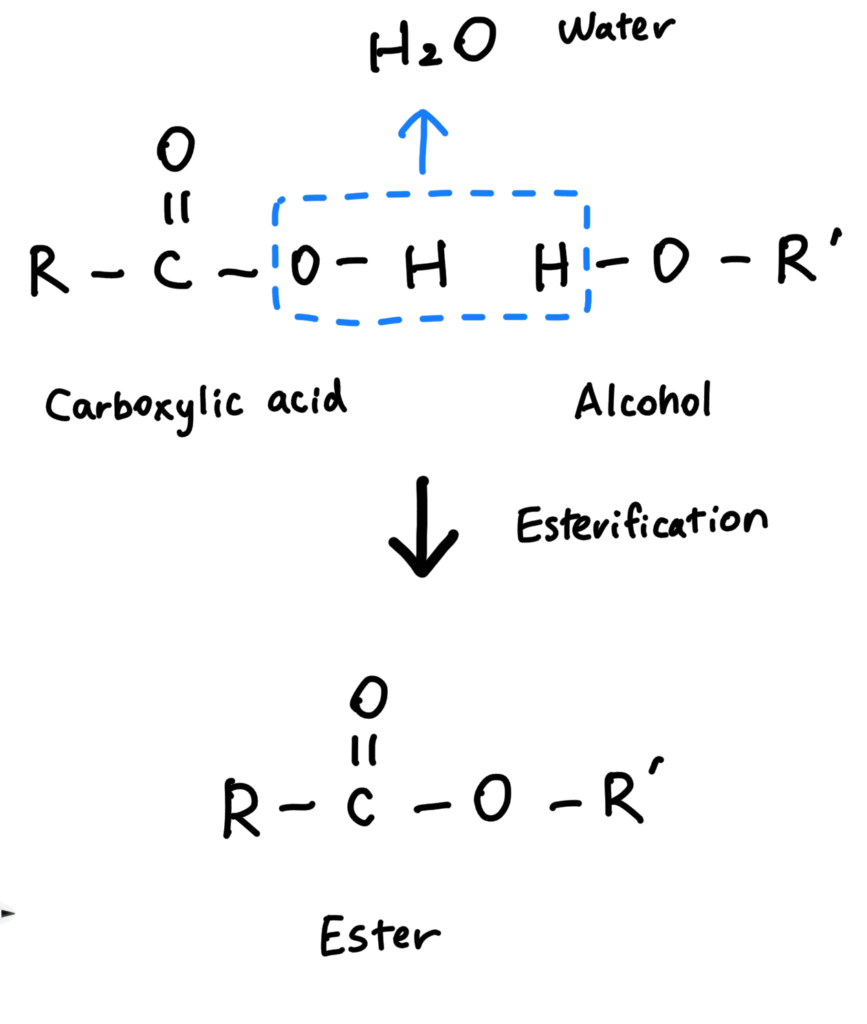
In pectin, galacturonic acid residues undergo this reaction, typically catalyzed by acid, forming methyl esters (–COOCH₃) via a protonated intermediate in aqueous conditions.
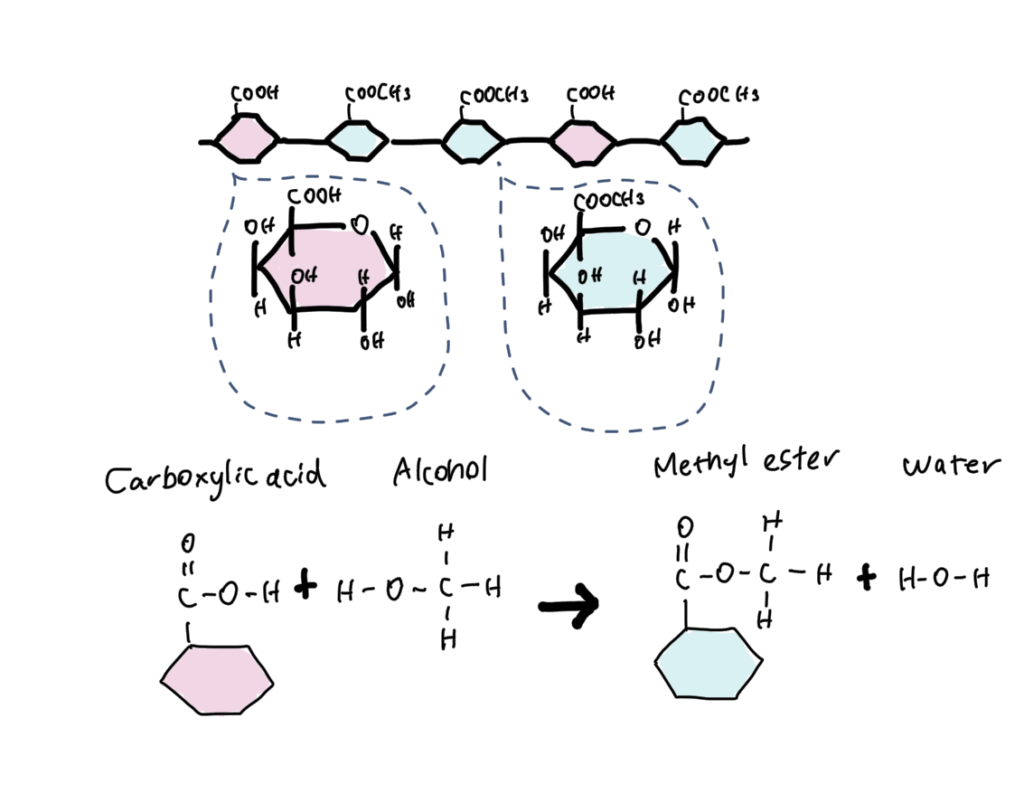
HM vs. LM Pectin: Different Gelation Mechanisms
High-Methoxyl Pectin
High-methoxyl pectin (HM pectin) forms gels in the presence of high sugar concentrations and acidic conditions.
Sugar molecules, rich in hydroxyl groups, strongly attract water through hydrogen bonding, reducing the amount of free water available to hydrate pectin chains.

This causes the chains to come closer together.
Additionally, under acidic conditions, carboxyl groups remain mostly unionized, minimizing repulsion between pectin molecules.
These factors, combined with hydrophobic interactions and hydrogen bonding among methyl ester groups, facilitate the formation of a stable gel network.
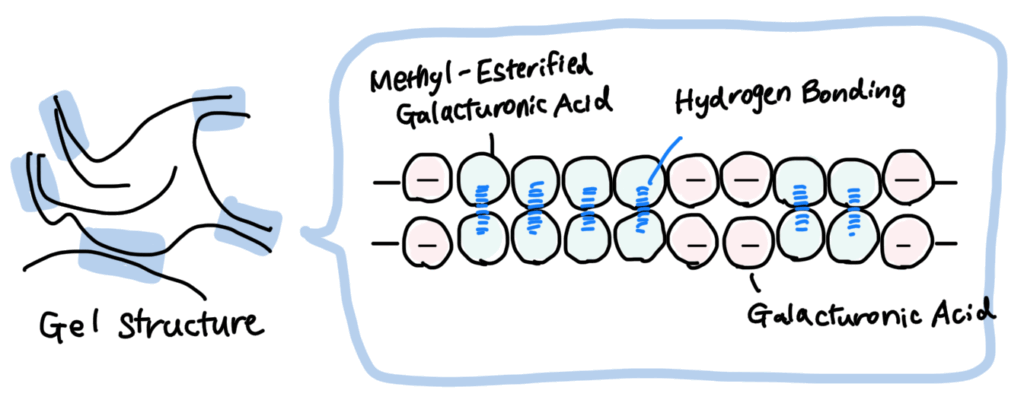
Low-Methoxyl Pectin
Low-methoxyl pectin (LM pectin), on the other hand, requires the presence of divalent cations like calcium (Ca²⁺) to form gels.
In neutral or slightly acidic environments, its carboxyl groups tend to ionize, creating negatively charged –COO⁻ sites that repel each other.
However, calcium ions can bridge these charges between adjacent pectin chains, creating ionic crosslinks.
This mechanism—known as the “egg-box model“—brings the chains together and stabilizes the gel structure.

LM Pectin + Calcium Salt = Better Swallowability
By combining LM pectin with calcium salts (e.g., calcium lactate), the gel:
- Provides re-cohesiveness even after being broken down
- Minimizes syneresis, helping retain internal moisture
- Maintains slipperiness and a smooth texture by retaining moisture within the gel, thereby improving ease of swallowing and helping reduce residue
Closing Thoughts
In our trial use, Isotonic Jelly seemed helpful for alternating swallowing and also appeared to support hydration in individuals with dysphagia.
Its squeeze-pouch design may appeal to some, particularly those reluctant to drink fluids.
Although jelly drinks may look similar, differences in formulation and gelling technology can influence swallowability.
By combining practical nursing experience with technical insights from patents, we can better evaluate such products.
As a nurse engaged in both clinical care and product research, I share these observations to support safer and more effective eldercare.
If you are interested in product evaluation, technical writing, or support for introducing healthcare products to the Japanese market, feel free to contact me via the Contact Form.
※This article is based on personal impressions and does not guarantee any effects.
References
McMurry, J. Organic Chemistry, 8th Edition. Tokyo Kagaku Dojin, 2012.
Urabe, Yoshitsune. Kagaku no Shin Kenkyu. Sanseido, 2019.
Aoyama, Toshiaki. Marugoto Zukai Sesshoku Enge Care. Shorinsha, 2017.
Kosei Rodosho (Ministry of Health, Labour and Welfare).
https://www.mhlw.go.jp/toukei/saikin/hw/jinkou/geppo/nengai24/dl/gaikyouR6.pdf
Shokuhin Labo (Unitec Foods Co., Ltd.).
https://shokulab.unitecfoods.co.jp/article/detail13/


